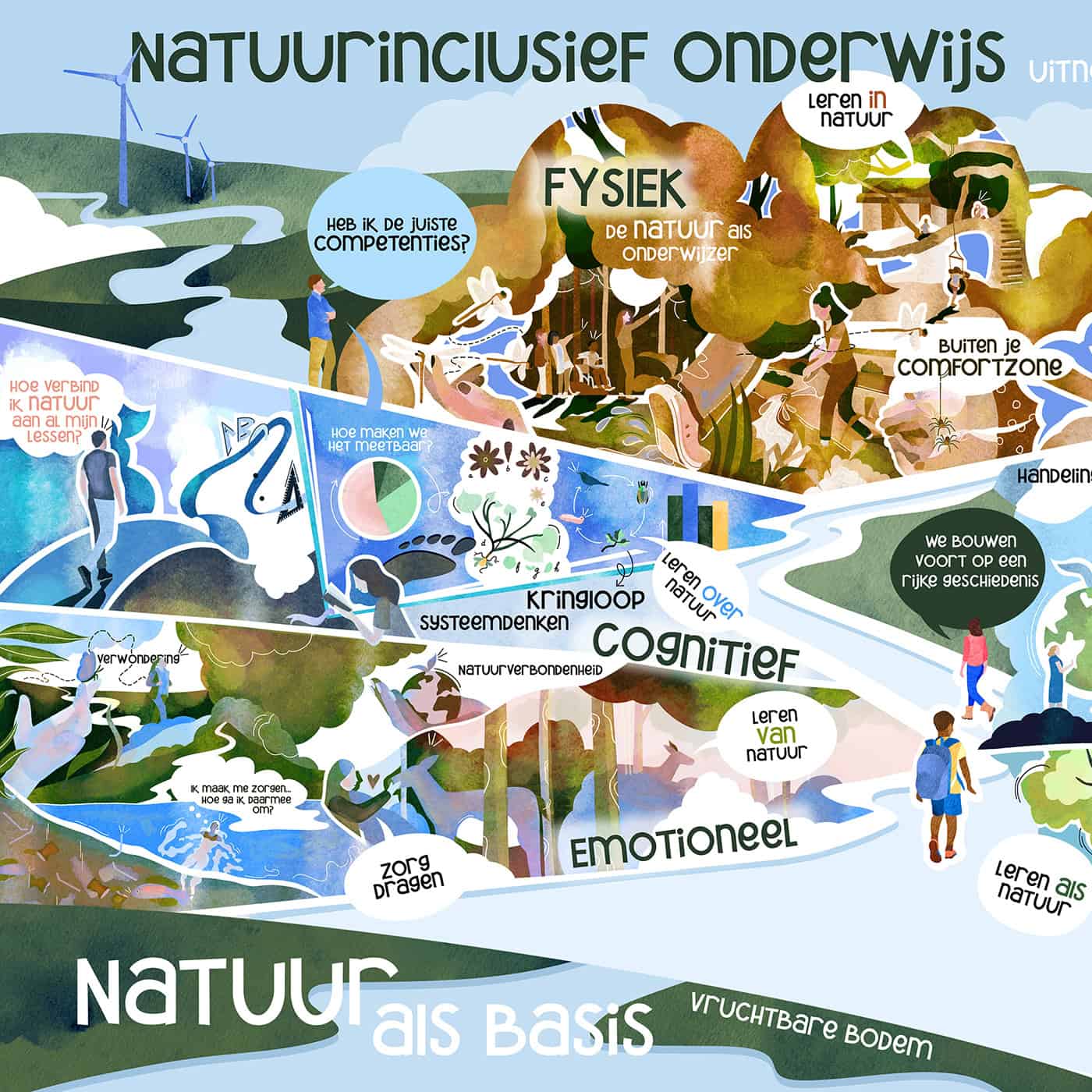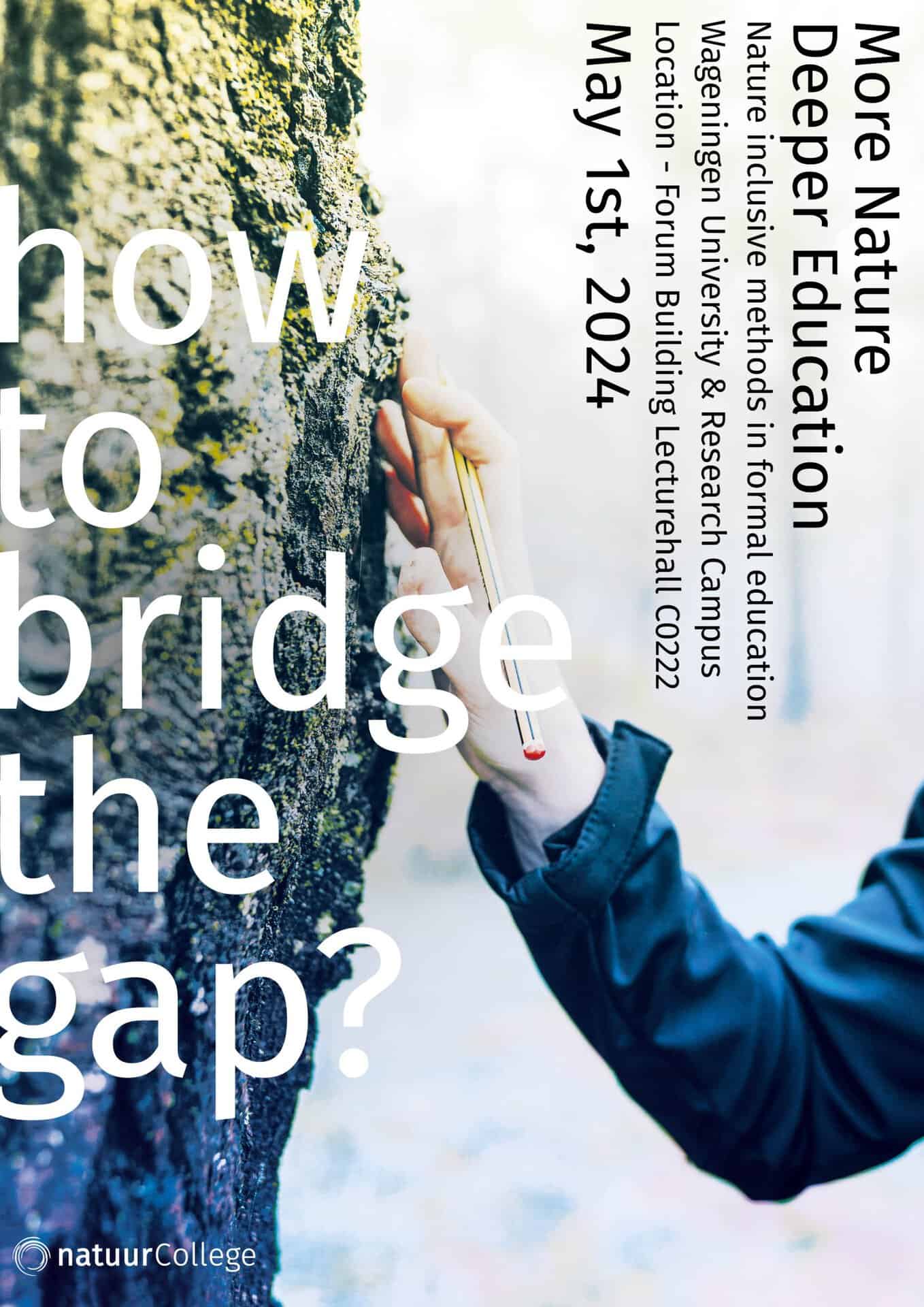PART TWO
In ten partial sessions, small groups delved into topics close to their own experiences.
Research and evaluation session
Maria Tengö en Reineke van Tol
How to research the effects of nature-inclusive education? A conversation emerged about the power and threat of bias when it comes to the relationship to ‘nature’ (in scientific terms: bias). The subject of ‘nature’, like the subject of ‘religion’, is not value-free. How do you measure effects if you cannot avoid the fact that by paying attention to nature, you also invite nature to have an impact? Participants shared their experiences. It is important not to stay within your own target group ‘bubble’; paying more attention to long-term effects (longer than three years) helps to make a ‘bias’ less influential; be alert to the difference between sustainable behaviour and connection with nature; indigenous cultures, for example, show that they do not always show sustainable behaviour but are connected to nature; do not stare blindly to avoid ‘bias’, because then you miss the very effects that the research itself brings about.
Student support session
Simon van der Els
We focused on creating a student support group at Wageningen University for those students feeling the weight of a changing world. During our research, it became clear that choosing the right words is important to reach the people who need it. The group you want to reach here may not yet be aware of their complaints. We quickly came to the point that we needed to focus on three things: (1) Convincing the right party within the educational institute that this initiative is important for the well-being of students and thus the university’s mission in its mission to train “changemakers”. (2) Integrate the right network of staff and facilitators in and around the education institution (Student support and training, student psychologists, student life coaches and more). (3) Designing and developing the right proposal including the why, how, what and where of such a network. For this, we want to integrate insights and data from relevant sources (including climate psychology). The next step is to draft such a design and collaborate with interested partners.
Session teacher training nature-inclusive
Marca Gresnigt
In this workshop, we looked at five domains of nature-inclusive learning to explore what this might look like in an academic setting. In small groups, we discussed physical, emotional, cognitive, spiritual and action-oriented aspects of nature-inclusive learning.
The physical domain was mainly seen as outdoor education, with nature supporting learning subjects. What about student safety in outdoor environments? What about wellbeing in indoor education? Back pain, burn-outs, not enough light and fresh air, unhealthy food, coffee…
The cognitive domain provoked a discussion on how nature can support the learning of theoretical subjects such as mathematics or language. Contact with nature elicits different vocabularies and invites reflection on how the use of language shapes relationships and actors. Learning in nature was linked to reciprocity – using nature not only for the quality of our lives, but also giving back to the whole. This domain brings fundamental reflection on ‘why do we do what we do’.
The emotional domain brought reflection on the role of psycho-emotional safety for learning. Through our inner nature, we can learn with and from nature. Nature can give us a sense of recognition in the learning process when we use natural materials. Nature invites a conversation about values.
Spirituality and science are not easily connected. Embodied learning is one way to enter this domain. What you feel and experience matters. Feeling connected to a bigger picture – having meaning. But also using intuition and making space for what we cannot measure and know. Little things like check-in/out can be important – changing the little ‘rituals’ in teaching that structure learning. It is important to be careful with this topic. One negative experience for a student can close the door.
In the autumn, we will teach the first version of the WUR course on nature-inclusive teaching. To be part of this, go to the site: Educational Staff Development Courses (wur.nl) or contact Marca Gresnigt (Teaching and Learning Canter WUR).
Session nature as a foundation in primary education
Anouk Tates en Marina Gorobevskaya
Because Het Zonnelied is an experiential, nature-immersed primary school, we designed the working group accordingly. lnstead of presenting a powerpoint, we immersed the participants in the experience of our methods. Not by explaining, but by modelling and facilitating the experience.
– designing with the natural learning cycle
– care routines of nature connection (how to pattern the brain to become a natural learner)
– demand-driven mentoring and the learning benefit
– telling stories that engage and integrate all senses, connection as a basis for peacemaking and self-regulation
– 8 character traits that develop as a result of deep connection with nature
– facilitating a connecting container
Call to action: we invite researchers to conduct research at our school. In our experience, many diagnoses (such as ADHD or ASD) become strengths and gifts in our natural environment. We would like to know why! We invite teachers or anyone working with children and young adults who wants to know more about our methods to get in touch. We have several learning modules to teach you about our methods. Contact Anouk Tates
Outdoor sensory education session
Beitske Bouwman
That a multisensory approach can be transformative was experienced by participants in the workshop given by Beitske Bouwman, Anaya Academy. Exploring the senses in the environment of the WUR opened several new perspectives. The softness of the leaves in the park were felt by a participant: ‘I never touch trees, it’s great!’ Slow walking was an invitation to experiment with this in professional life: ‘I think I will go outside more during my work, I might be able to make my phone calls by walking instead of sitting at my desk,’ mentioned a participant who works as a policy maker. We are nature, if we start taking care of our own inner nature, we can change the world around us. And we can already start changing our own behaviour in daily life. Or as one student put it after the session: ‘Tomorrow I am going to ask my coach to coach me outside’.
Session lessons from practice in secondary schools
Ester Klein Hesselink
How do you bring deep learning into secondary education? In this workshop, we will discuss a living lab for deep (outdoor) learning that Wageningen Pre-University will organise for secondary school teachers starting in September. Ester Klein Hesselink went into the field to find out what questions and needs teachers have to get started with deep (outdoor) education in their lessons. Her experience with the ‘Parliament of Earthlings’ project was very recognisable to the participants. A role-play was held with the participants to allow the Wild Pedagogues (who want to develop wild pedagogy as part of everyday life) and the Wild Teachers (who need practical teaching principles) to give each other tips and starting points. There was a discussion on how to make our (seemingly) different thinking on education and learning goal attainment overlap more. One outcome was that going outside means taking in other perspectives from other cultures, customs, ideals and other environments. This calls for more reflexive and reflective education that often struggles to relate to testing and draws more on one’s own and others’ direct experience (phenomenological).
Session different dimensions of nature-inclusive education
Merel Collenteur
In this session, we focused on integrating the different dimensions of nature-inclusive education. Nature-inclusive learning methods, such as flow drawing, inquiry-based learning and embodied learning, offer effective ways for this holistic, integrated approach. We experience nature-inclusive learning methods to encourage enthusiasm and curiosity. Coyote teaching encourages students to dive deeper into the mystery, rather than ending the learning process with a quick answer. With this experience in mind (and body), we designed a number of learning methods for nature-inclusive teaching. This resulted in embodied experiences for students that combine art, music, nature, meditation and specific knowledge. Ask more questions, it will foster your curiosity and gratitude for life!
Climate emotions in the classroom
Elisabet Dueholm Rasch
In the workshop on climate emotions, we talked about how we can use storytelling in our education to deal with climate emotions. We also exchanged many experiences about dealing with emotions in education more generally and how we can find the balance between paying attention to this but not playing therapist.
Reconnecting with Nature you reconnect with your own inner nature
Prinses Irene van Lippe-Biesterfeld en Karin Oeseburg
Participants were challenged to walk in silence and focus on the natural elements around them, contrasting with the busy, man-made environment of the campus. After a journey through parking lots and between buildings, they finally reached an idyllic spot in the nature garden behind the Alterra building. Here the participants shared personal stories about their connection with nature, then the participants were invited to lie on their stomachs and focus on life within half a square meter in front of them. As they observed the diversity of plants and insects, they realized that nature simply ‘is’, without judgment or haste. This insight led to a deeper understanding of patience and respect for the time it takes to live in harmony with the earth.





